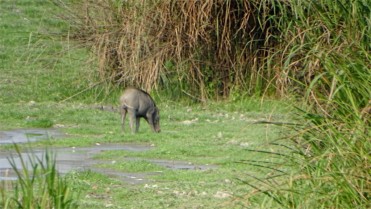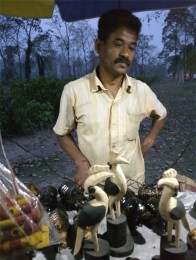We had a wonderful sighting of a brown fish owl (Ketupa zeylonensis) sitting in the canopy of a large tree. It would have been invisible from above. As we drove close to the edge of the road, we could look up and see it clearly. It was trying very hard to ignore us and continue to sleep. The fish owl does not have the deep bowl-like face which is so characteristic of many owls. That bowl is acts as an antenna to focus sound, since hearing is very important to most nocturnal hunters. The fish owls are less dependent on sound since they feed on crabs and molluscs. A study in Melghat Tiger Reserve found that they also eat insects and rodents, so hearing cannot be unimportant. I’m sure that they are fairly opportunistic, and will change to fish and frogs if they are abundant.
We have usually sighted this fleetingly at night: on tree stumps or flying about. I had a wonderful view of it sitting in the middle of a lawn in Valparai, but the light was not good enough for a photo. This one, with its head tucked in, looked more squat than the others I’ve seen. One does see the related tawny and buff fish owls in Assam, but this was not one of those rarer birds. As we watched, it opened its eyes. My hand shivered slightly as I saw those sleepy yellow eyes looking at me.
All owls present in the world today diverged from a common ancestor more than 9 million years ago. This was a time when great geological changes were afoot, including the continuous raising of the Himalayas and the closing of the Tethys sea, so changing the global climate. The fish owls (genus Ketua) could have diverged later, but they are so closely related to other owls with prominent ear tufts (genus Bubo), that they are now included in the same genus. There have been contemporary local extinctions of the brown fish owl, notably in Israel where the poisoning of rats led to a local extinction of K. zeylonensis. There are still people alive in Europe who have seen brown fish owls, although they are now extinct. They were spotted again in Anatolia five years ago. It can be found now in a large range from Asian Turkey to south-east Asia. This is the reason it is considered to be not of concern for conservation work.







































